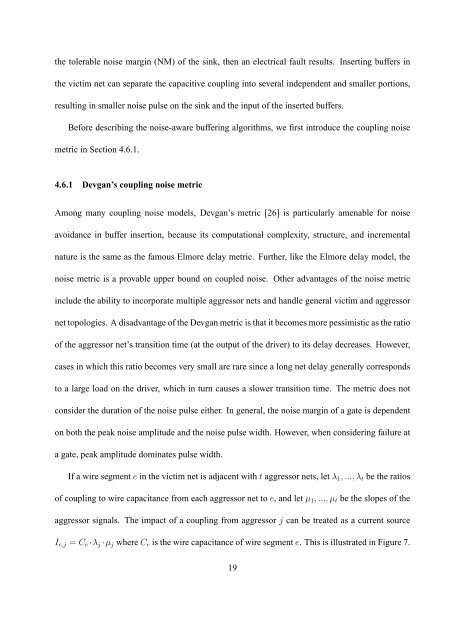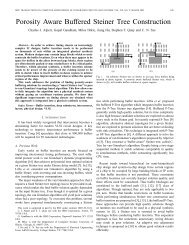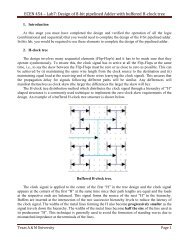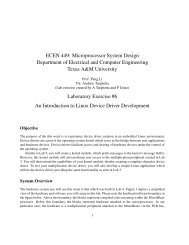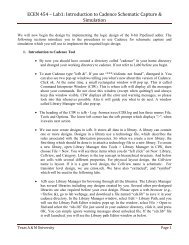Buffer Insertion Basics - Computer Engineering & Systems Group ...
Buffer Insertion Basics - Computer Engineering & Systems Group ...
Buffer Insertion Basics - Computer Engineering & Systems Group ...
You also want an ePaper? Increase the reach of your titles
YUMPU automatically turns print PDFs into web optimized ePapers that Google loves.
the tolerable noise margin (NM) of the sink, then an electrical fault results. Inserting buffers in<br />
the victim net can separate the capacitive coupling into several independent and smaller portions,<br />
resulting in smaller noise pulse on the sink and the input of the inserted buffers.<br />
Before describing the noise-aware buffering algorithms, we first introduce the coupling noise<br />
metric in Section 4.6.1.<br />
4.6.1 Devgan’s coupling noise metric<br />
Among many coupling noise models, Devgan’s metric [26] is particularly amenable for noise<br />
avoidance in buffer insertion, because its computational complexity, structure, and incremental<br />
nature is the same as the famous Elmore delay metric. Further, like the Elmore delay model, the<br />
noise metric is a provable upper bound on coupled noise. Other advantages of the noise metric<br />
include the ability to incorporate multiple aggressor nets and handle general victim and aggressor<br />
net topologies. A disadvantage of the Devgan metric is that it becomes more pessimistic as the ratio<br />
of the aggressor net’s transition time (at the output of the driver) to its delay decreases. However,<br />
cases in which this ratio becomes very small are rare since a long net delay generally corresponds<br />
to a large load on the driver, which in turn causes a slower transition time. The metric does not<br />
consider the duration of the noise pulse either. In general, the noise margin of a gate is dependent<br />
on both the peak noise amplitude and the noise pulse width. However, when considering failure at<br />
a gate, peak amplitude dominates pulse width.<br />
If a wire segment e in the victim net is adjacent with t aggressor nets, let λ 1 ,...,λ t be the ratios<br />
of coupling to wire capacitance from each aggressor net to e, and let µ 1 ,...,µ t be the slopes of the<br />
aggressor signals. The impact of a coupling from aggressor j can be treated as a current source<br />
I e,j = C e ·λ j ·µ j where C e is the wire capacitance of wire segment e. This is illustrated in Figure 7.<br />
19


